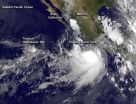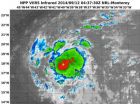(Press-News.org) The bluetongue virus, which causes a serious disease that costs the
cattle and sheep industries in the United States an estimated $125
million annually, manages to survive the winter by reproducing in the
insect that transmits it, report veterinary scientists at the
University of California, Davis.
The findings solve a century-old mystery and are particularly
significant as global climate change brings more moderate winter
temperatures around the world. The new study appears Sept. 12 in the
journal PLOS ONE.
"By conducting this epidemiological study on a commercial dairy farm
in Northern California, we were able to demonstrate that the virus
overwinters in female midges that had fed on an infected animal
during the previous season," said lead author Christie Mayo, a
veterinarian and postdoctoral researcher in the UC Davis School of
Veterinary Medicine.
"This discovery has important ramifications for predicting the
occurrence of bluetongue in livestock and, we hope, for eventually
developing controls for the disease," said co-author James
MacLachlan, a UC Davis veterinary professor and viral disease expert.
About bluetongue
Bluetongue disease, first identified during the 1800s in southern
Africa, is transmitted by the Culicoides biting midge, a tiny gnat
sometimes referred to as a "no-seeum."
The disease mostly sickens sheep but also infects cattle and goats,
as well as deer and other wild ruminants. In the U.S., the virus'
greatest economic impact is in the cattle industry, because it is
bigger than the domestic sheep industry and most adversely impacted
by international trade barriers related to bluetongue. The disease
does not pose a threat to human health.
The name bluetongue derives from the swollen lips and tongue of
affected sheep, which may turn blue in the late stages of the disease.
The virus that causes bluetongue was first isolated and identified in
the Western Hemisphere in the early 1950s at the UC Davis School of
Veterinary Medicine.
A seasonal mystery
In California, bluetongue is most prevalent when midges are abundant
in late summer and fall, but there has been speculation over how the
virus survives through the winter. When temperatures turn cold and
the biting-midge populations plummet, transmission appears to cease
for more than six months, but the virus reappears when temperatures
warm the following season.
Findings from California dairy
The researchers monitored cows and midges on a Northern California
dairy farm for more than a year. They documented, for the first time,
the presence of genetic material for the bluetongue virus in female
midges that were collected during two consecutive winter seasons.
The bluetongue virus was widespread in both the dairy cows and the
midges from August to November. Surprisingly, however, the
researchers discovered that the virus was also present in female
midges captured in February of both 2013 and 2014. There was no sign
of infection in the dairy cattle being studied.
The researchers concluded that those long-lived female midges had
been infected with the bluetongue virus during the previous
warm-weather season. They were carrying the virus through the winter
months and would later in the season once again transmit it to cows
on the dairy.
The research team notes that the bluetongue virus may also have
additional, yet-to-be discovered, modes of overwintering in temperate
regions.
INFORMATION:
Other members of the research team were William K. Reisen and Cameron
J. Osborne, both of UC Davis; E. Paul J. Gibbs of the University of
Florida, Gainesville; Bradley A. Mullens of UC Riverside; and Ian A.
Gardner of Atlantic Veterinary College, Charlottetown, Prince Edward
Island, Canada.
Funding for the study was provided by the U.S. Department of
Agriculture's National Institute of Food and Agriculture, and the UC
Davis School of Veterinary Medicine's Center for Food Animal Health.
About UC Davis
UC Davis is a global community of individuals united to better
humanity and our natural world while seeking solutions to some of our
most pressing challenges. Located near the California state capital,
UC Davis has more than 34,000 students, and the full-time equivalent
of 4,100 faculty and other academics and 17,400 staff. The campus has
an annual research budget of over $750 million, a comprehensive
health system and about two dozen specialized research centers. The
university offers interdisciplinary graduate study and 99
undergraduate majors in four colleges and six professional schools.
Media contacts:
-- James MacLachlan, School of Veterinary Medicine, (530) 754-8125,
njmaclachlan@ucdavis.edu
-- Christie Mayo, School of Veterinary Medicine, cemayo@ucdavis.edu
-- Pat Bailey, UC Davis News Service, (530) 752-9843,
pjbailey@ucdavis.edu
Study solves the bluetongue disease 'overwintering' mystery
2014-09-12
ELSE PRESS RELEASES FROM THIS DATE:
Tropical Storm Odile expected to 'eat' Tropical Depression 16E
2014-09-12
The image of the Eastern Pacific Ocean and the two storms was taken at 8 a.m. EDT (5 a.m. PDT) on September 12. It shows that Tropical Depression 16E (TD16E) is about 10 times smaller in comparison to Tropical Storm Odile, located to its east. NOAA manages the GOES-West satellite but the image was created by the NASA/NOAA GOES Project at NASA's Goddard Space Flight Center in Greenbelt, Maryland.
The National Hurricane Center noted that TD16E is unable to intensify because of its close proximity to Tropical Storm Odile.
Forecaster Pasch at NOAA's National Hurricane Center ...
A wife's happiness is more crucial than her husband's in keeping marriage on track
2014-09-12
When it comes to a happy marriage, a new Rutgers study finds that the more content the wife is with the long-term union, the happier the husband is with his life no matter how he feels about their nuptials.
"I think it comes down to the fact that when a wife is satisfied with the marriage she tends to do a lot more for her husband, which has a positive effect on his life," said Deborah Carr, a professor in the Department of Sociology, School of Arts and Science.
"Men tend to be less vocal about their relationships and their level of marital unhappiness might not be ...
NASA sees Tropical Storm Kalmaegi swirl toward the Philippines
2014-09-12
Tropical Depression 15W intensified during the early morning hours of September 12 and became a tropical storm re-named "Kalmaegi." NASA's Aqua satellite passed overhead as the storm intensified.
The MODIS instrument, known as the Moderate Resolution Imaging Spectroradiometer that flies aboard NASA's Aqua satellite captured a visible image of Tropical Storm Kalmaegi approaching the Philippines on Sept. 12 at 4:45 UTC (12:45 a.m. EDT). The image showed tightly-curved bands of thunderstorms over the northern and southern quadrants of the storm that were wrapping into a ...
NASA-NOAA Suomi NPP sees formation of Tropical Storm Edouard
2014-09-12
The sixth tropical depression of the Atlantic Ocean hurricane season formed in the central Atlantic Ocean yesterday, and today, September 12, it strengthened into Tropical Storm Edouard. NASA-NOAA's Suomi NPP satellite flew over Edouard and provided forecasters with an infrared view of what's happening within the strengthening storm.
When Suomi NPP passed over Edouard on September 12 at 04:37 UTC (12:37 a.m. EDT), the Visible Infrared Imaging Radiometer Suite or VIIRS instrument aboard captured an infrared image of the storm. The infrared data shows temperature, an indicated ...
Worldwide study demonstrates accuracy of genetic analyses
2014-09-12
JACKSONVILLE, Fla., Sept. 12, 2014 — Physicians envision a future in which genomic data from patients is heavily used to manage care — but experts have questioned the accuracy and reliability of these analyses. Now, a study by 150 researchers in 12 countries finds real strength and agreement across RNA genomic sequencing techniques and laboratories — as well as ways to improve what little variability exists to set a new high standard.
The results of the study were published in Nature Biotechnology in three separate research articles.
These results should provide assurance ...
Tropical Storm Odile taken on by 2 NASA satellites
2014-09-12
As Tropical Storm Odile continues to affect Mexico's west coast and stir up dangerous surf, NASA's TRMM and Aqua satellites provided forecasters information on clouds and rainfall in the coast-hugging storm. On September 12, A Tropical Storm Watch remained in effect from Manzanillo to Cabo Corrientes, Mexico.
Tropical Storm Odile formed on September 10, 2014 in the same area where Norbert formed.
Gathering Rainfall and Thunderstorm Height Information
The Tropical Rainfall Measuring Mission or TRMM satellite flew over tropical storm Odile on September 11, 2014 at ...
CCNY analysis explains rich bird biodiversity in Neotropics
2014-09-12
Applying analyses designed by City College of New York biologist Mike Hickerson, a team of international researchers is challenging a commonly held view that explains how so many species of birds ended up in the Neotropics, an area rich in rain forest extending from Mexico to the southernmost tip of South America. It is home to the most bird species on Earth.
"The unanswered question has been—how did this extraordinary bird diversity originate?" said Dr. Brian Smith, lead author of a paper on the subject published in the journal Nature this week and an assistant curator ...
Fluid mechanics suggests alternative to quantum orthodoxy
2014-09-12
The central mystery of quantum mechanics is that small chunks of matter sometimes seem to behave like particles, sometimes like waves. For most of the past century, the prevailing explanation of this conundrum has been what's called the "Copenhagen interpretation" — which holds that, in some sense, a single particle really is a wave, smeared out across the universe, that collapses into a determinate location only when observed.
But some founders of quantum physics — notably Louis de Broglie — championed an alternative interpretation, known as "pilot-wave theory," which ...
Corn spots: Study finds important genes in defense response
2014-09-12
When corn plants come under attack from a pathogen, they sometimes respond by killing their own cells near the site of the attack, committing "cell suicide" to thwart further damage from the attacker. This cell sacrifice can cause very small, often microscopic, spots or lesions on the plant.
But up until now it's been difficult to understand how the plant regulates this "spotty" defense mechanism because the response is so quick and localized.
Researchers at North Carolina State University have identified a number of candidate genes and cellular processes that appear ...
Experts call for massive global response to tackle Ebola
2014-09-12
AUDIO:
Professor Peter Piot, Director of the London School of Hygiene & Tropical Medicine, explains how he co-discovered the Ebola virus in 1976, and gives his views on the current Ebola...
Click here for more information.
The current Ebola outbreak now requires a "rapid response at a massive global scale", according to experts at the London School of Hygiene & Tropical Medicine.
Writing an editorial in Science, Professor Peter Piot, co-discoverer of the virus, says that the ...




